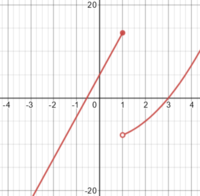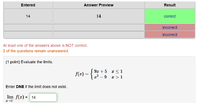You are using an out of date browser. It may not display this or other websites correctly.
You should upgrade or use an alternative browser.
You should upgrade or use an alternative browser.
I got the right answer but confused about logic
- Thread starter kory
- Start date
lev888
Elite Member
- Joined
- Jan 16, 2018
- Messages
- 2,939
Why are you plugging in 0?If I'm approaching 1 from the left, then that means I should be able to plug 0 into the function. So why does 0 not work but 1 does?
Dr.Peterson
Elite Member
- Joined
- Nov 12, 2017
- Messages
- 16,091
The limit asked me to approach from the left of 1. Left of 1 is zero....
It also states that x can be <= to 1. Therefore any number less than 1 should be a number that I could plug in. So I chose 0 and it failed. If thats the case then the limit is NOT a number <= to 1. Its just 1.
In calculus, "number" does not mean integer! To the left of 1 are numbers like 0.9999999999999. As x approaches 1 from the left, getting closer and closer through numbers like that, what does the function approach? What will happen if you just plug in 1?
You might try graphing the function.
pka
Elite Member
- Joined
- Jan 29, 2005
- Messages
- 11,971
The notation \(\mathop {\lim }\limits_{x \to \bf{1^ - }} \) means that \(x\) is close to \(1\) on the left (the negative) side.It also states that x can be <= to 1. Therefore any number less than 1 should be a number that I could plug in. So I chose 0 and it failed. If thats the case then the limit is NOT a number <= to 1. Its just 1.
It may not be clear to you but \(0\) is not close to \(1\); in fact \(0.999999\) is not close to \(1\) in mathematical terms.
What is look at the problem. If you to evaluate \(f\left(0.999999\right)\) what would you use.
I hope your answer would be \(9x+5\) or \(9(0.999999)+5\sim 14\).
You must learn that limits are never, never solved by substitution. They are solved by logical approximations.
Dr.Peterson
Elite Member
- Joined
- Nov 12, 2017
- Messages
- 16,091
Presumably you are learning about what limits mean, and specifically what "approach from the left" means; that's what you need to figure out.Hmmm...I guess I gotta keep tinkering with it.
I got all of the answers right. Just a little confused on the wording.
Have you tried discovering what it means by doing the things we've suggested? One is to draw the graph, and see what happens to y as you move a point along it toward x=1. Another is to calculate values of y for values of x like 0, .5, .9, .99, ... approaching 1 from the left.
In both cases, the limit they are asking for is the number that y approaches as you do these things; what you'll discover is that, because this function is continuous to the left of x=1, that limit is exactly what you get when you plug in x=1.
What you need to see is why that is true, and how you can know it for yourself without having to ask.
What part of the wording still confuses you?
Sounds like your talking about Epsilon and Delta. As a point gets approached on x then the other point moves along y.... Correct?Presumably you are learning about what limits mean, and specifically what "approach from the left" means; that's what you need to figure out.
Have you tried discovering what it means by doing the things we've suggested? One is to draw the graph, and see what happens to y as you move a point along it toward x=1. Another is to calculate values of y for values of x like 0, .5, .9, .99, ... approaching 1 from the left.
In both cases, the limit they are asking for is the number that y approaches as you do these things; what you'll discover is that, because this function is continuous to the left of x=1, that limit is exactly what you get when you plug in x=1.
What you need to see is why that is true, and how you can know it for yourself without having to ask.
What part of the wording still confuses you?
Dr.Peterson
Elite Member
- Joined
- Nov 12, 2017
- Messages
- 16,091
I wasn't explicitly referring to epsilon and delta, just to the informal idea of a limit. And I want you mostly to think informally. Again, have you done any of the things we suggested, which are meant to help you do that?Sounds like your talking about Epsilon and Delta. As a point gets approached on x then the other point moves along y.... Correct?
But, yes, as you change x, y = f(x) also changes, so the point (x,y) moves along the graph.
The question is, do you see yet why in your problem, as x approaches 1 from the left, y will approach f(1) = 14?
And then, do you see what this is not true as you approach from the right?
Here's the graph:

Im taking calculus 1 class over the summer. Im only 4 days in and we move extremely fast. Some of the things you say havn't completely clicked yet..I'm getting there though...I wasn't explicitly referring to epsilon and delta, just to the informal idea of a limit. And I want you mostly to think informally. Again, have you done any of the things we suggested, which are meant to help you do that?
But, yes, as you change x, y = f(x) also changes, so the point (x,y) moves along the graph.
The question is, do you see yet why in your problem, as x approaches 1 from the left, y will approach f(1) = 14?
And then, do you see what this is not true as you approach from the right?
Here's the graph:
View attachment 27648
Steven G
Elite Member
- Joined
- Dec 30, 2014
- Messages
- 14,383
Pick any point on the graph where the x value is to the left of 1. What is that y value? Then following the curve move to the right so you are getting closer to x=1 (but still less than 1). What is the y value now? Move along the curve closer to x=1, but still to the left of x=1. What is the y value. Now you are probably very close to x=1. Still move along the curve getting closer to x=1, but still to the left. What is the x-value? Now you should be extremly close to x=1, but to the left of x=1. What is the y value? What are these y values approaching? This is your (left hand) limit.

